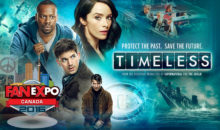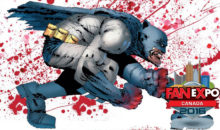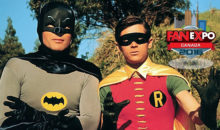Automotive Icons of Television and Film
Unless you’ve been trapped in an Ecto Containment Unit for the better part of a year, you’re aware that a Ghostbusters reboot is in development. The production has been receiving a lot of flak from online fans. Some of the flak is directed at the idea of reboots in general. Some of the flak is due to an apparent failure to involve the original Ghostbusters cast. Some of the flak is being focused at the new, all-female team. And some of the flak has been at the orange stripes on the Ghostbusters uniform. (really?)
But I’m not here to talk politics. I’m here to talk cars. Last week, Paul Feig, director and co-writer of the Ghostbusters reboot, posted to Twitter some images of the new Ecto-1. Ecto-1 is, of course, the transportation of choice for the Ghostbusters team. The reveal of the rebooted Ecto-1 seems as good an excuse as any to look back at some of my favourite iconic vehicles from the era of the original Ecto-1. Along the way, we can consider some of the reboots imposed on these automotive icons of the past.
1. General Lee
For six years from 1979 to 1985, those good ol’ boys from Hazzard County outran Sheriff Roscoe P. Coltrane in the General Lee. The General was a 1969 Dodge Charger stock car with doors welded shut and ‘01’ painted on the sides. Named for General Robert E. Lee it also had a horn that played the first twelve notes of “Dixie” and a Confederate flag painted on the roof. The car was the true star of The Dukes of Hazzard and received more than its fair share of the fan mail.
In 2005, the creators of The Dukes of Hazzard film avoided making any significant changes to the General Lee. Even the Confederate flag was retained despite its association with, and use by, white supremacists. However, a recent backlash against the use of the Confederate flag is resulting in a retroactive reboot of the General Lee. Warner Brothers Entertainment has announced that they have ceased production on General Lee toys and the show has been pulled from TV Land’s programming lineup. Professional golfer Bubba Watson, owner of one of the original General Lees, has posted on Twitter that he will have the roof of the car painted over. Damn it, I’m talking politics again! Moving on…
2. K.I.T.T.
CBS had The Dukes of Hazzard. In 1982, NBC countered with Knight Rider. Knight Rider told the story of Michael Knight, a crime fighter devoted to helping the powerless. Knight, as portrayed by David Hasselhoff, is aided in his missions by his high-tech, artificially intelligent car. The Knight Industries Two Thousand, or K.I.T.T., was a 1982 Pontiac Trans Am with voice provided by actor William Daniels.
K.I.T.T. received some small modifications over the four year run of the series. Most of these were made to the interior of the car to make the dashboard appear more high tech.
In 1991, the television movie Knight Rider 2000 replaced the Trans Am with a red, custom, 1991 Dodge Stealth known as the Knight Industries Four Thousand, or K.I.F.T. In 2008, a new Knight Rider series aired and introduced us to the Knight Industries Three Thousand (also K.I.T.T. for short just to cause confusion). In this iteration, K.I.T.T. was a 2008 Ford Mustang Shelby voiced by Val Kilmer. It certainly made sense that a technologically advanced vehicle would be upgraded to more modern automotive designs. But fans will forever associate Knight Rider with the ’82 Trans Am and neither of these reboots was particularly successful.

Knight Industries 4000 from Knight Rider 2000 in 1991 and Knight Industries 3000 from 2008. Is that clear?
3. The Car
Not all intelligent automobiles are fighting for the side of good. Case in point, the titular vehicle of 1977’s The Car is a demon vehicle that arrives in a small western town for the sole purpose of killing off its citizens. A custom 1971 Lincoln Continental Mark III, The Car was designed by famous car customizer, George Barris. (Barris was involved, in one way or another, with many of the cars on this list.) The Car’s spree of terror included pushing police cars off cliffs, running cyclists off the road, and smashing through a home to run down its occupant. All the while, The Car mocked its victims with a deep, fluttery horn that sounded like a throaty laugh. The Car’s reign of terror ended when James Brolin and a misfit team of locals buried it under a mountain of rock. Surprisingly, a reboot of The Car has yet to surface.
4. Christine
The Car has never had a sequel or reboot but Christine is a spiritual descendant. Directed by John Carpenter and based on the novel by Stephen King, the 1983 film starred a 1958 Plymouth Fury with a penchant for murder. Christine’s motivations are clearer than her precursor. She is driven (no pun intended) by jealousy and revenge. She meets her demise under the treads of a bulldozer…or does she?
5. Mystery Machine
Since 1969 Scooby-Doo and the gang have been travelling between mysteries in the aptly named Mystery Machine. Although it is difficult to pin down the lineage of an inconsistently drawn vehicle, best bet is that the Mystery Machine is a 1965 Chevrolet Corvair Greenbrier. In the late 1990’s, there was an attempt to drag the entire gang into the modern era. This resulted in the update of the Mystery Machine to what appeared to be a Chevrolet Astro circa 1998. The update didn’t take, however, as more recent incarnations of both the gang and the Mystery Machine have reverted to the original designs. In 2002, the live-action Scooby Doo movie remained fairly true to the original Mystery Machine. The paint scheme was altered slightly and the large orange flowers were discarded but the retro feel was retained.
6. Elvira’s Macabre Mobile
Elvira, Mistress of the Dark is a horror hostess portrayed by Cassandra Peterson. A gothic cross between a vampire and a valley girl, Elvira needed a car to match her stunning appearance and personality. Thus with her 1998 film debut (named, appropriately enough, Elvira: Mistress of the Dark), the Macabre Mobile was born. The Macabre Mobile is a 1959 Ford Thunderbird Convertible customized with appropriately gothic touches. The custom grill has a spider web motif, the steering wheel was a pentagram, and the rear view mirror was framed in barbed wire.
According to Peterson, the car disappeared for 10 years after the film was finished. Somehow it found its way into her possession but was in rough shape. It has, therefore, been reworked several times including most recently on an episode of Counting Cars in 2012. During one of the updates, the steering wheel and stick shift were replaced, the dashboard was overrun with skulls, the hood ornament was modified to look like Elvira, and the original front fender chrome ornaments were replaced with skeletal hands with eyeballs on top. The end result? Well, the hood ornament is pretty cool. The skeletal hands on the fenders and dashboard are a bit too much. Overall, I’m left thinking less is more.
7. DeLorean Time Machine
When Doc Brown (Christopher Lloyd) built his time machine, his choice to use a DeLorean DMC-12 was based mainly on style. With its gull wing doors and brushed stainless steel body, it looks futuristic but in a retro kind of way. Doc’s additions to support his time machine including exposed wiring, LED displays, and the Flux Capacitor give a feeling of high tech meeting low tech. This is perfectly aligned with the Back to the Future trilogy’s time jumping storylines.
The DeLorean went through multiple configurations throughout the three films. However, the changes occurred organically as part of the plot. At the end of the first movie, Doc took the DeLorean into the future. While there, he updated the time machine to use a Mr. Fusion in place of plutonium as a power source. He also had a hover conversion done on the DeLorean to allow it to fly. This configuration was used throughout the second film.
At the end of Back to the Future Part II, Marty (Michael J. Fox) is trapped in 1955 while Doc Brown is stuck in 1885 with a damaged DeLorean. In Back to the Future Part III, Doc buries the DeLorean so Marty can retrieve it seventy years later in 1955. Marty and the Doc from 1955 repair the time machine using 1955 era parts (strapped to the hood of the car). During its long burial, the DeLorean’s tires had rotted away so they replace the wheels with white wall baby moons.
In this latest configuration, Marty goes back to 1885 to rescue Doc Brown. Unfortunately the DeLorean is again damaged resulting in all the gasoline leaking from the car. In order to get the DeLorean to the speed necessary for time travel (88 miles per hours), Doc devises a scheme to push the DeLorean with a locomotive. Therefore, they make one final modification to replace the DeLorean’s wheels with railway car wheels.

Upon its returns to 1985, the DeLorean is destroyed by a modern train thus crushing any thought of further modifications.
8. Batmobile
Oh man, where to start? How about with the Batmobile designed by George Barris for the 1966 television show, Batman? It is certainly not the first Batmobile or even the first on-screen incarnation. However, it is not only the most recognized Batmobile but one of the most recognized cars in the world. It was based on a 1955 Lincoln Futura concept car and had every bat-accoutrement a hard working superhero could want.
In 1979, more than ten years after Batman had ended, Batman and Robin (still portrayed by Adam West and Burt Ward) and the Batmobile were called back into service for two one-hour television specials known as Legends of the Superheroes. On these specials, the Batmobile can be seen to have had some upgrades (or downgrades depending on your preference). The car was painted a flat black instead of its more familiar glossy finish, the bat logos were absent from the doors, and it rode on spoke wheels.
It seems a little hard to believe now but, back in 1989 Tim Burton’s Batman film was considered a darker, grittier version of the Dark Knight. Your average non-comic-reader still thought of the campy Adam West television show when they heard the name Batman. Calling Burton’s version a reboot makes too strong an association between a show and movie that are very dissimilar. Burton’s Batmobile, as designed by Anton Furst, was a complete rework with only the rear jet exhaust and the 180° Bat Turn reminiscent of the earlier vehicle. This variation of the Batmobile would also prove to be extremely popular. Its first onscreen appearance invoked applause from movie goers.
Burton directed both Batman and Batman Returns before handing the reigns over to Joel Schumacher for Batman Forever in 1995. With a new director came a new aesthetic and a new Batmobile designed by Barbara Ling. The Batman Forever Batmobile, like the film in which it appears, is much brighter and garish. The body of the car had wide cuts down the side giving the impression of ribs behind which the engine and undercarriage could be seen. The engine, undercarriage, and wheels also glowed blue while the jet exhaust spit out a neon red flame. The design was not particularly well received.
Batman & Robin (1997) was Schumacher’s final shot at a Batman movie. He again used Barbara Ling as production designer. Ling designed an all-new Batmobile stating that she was dissatisfied with the Batmobile in Batman Forever as it did not have a strong enough screen presence. For Batman & Robin, she wanted a Batmobile that would seem larger than life. The result was a Batmobile with even more body cut-outs and even more lights. Not satisfied with only using blue lights, Ling had a complicated lighting system consisting of red, orange, yellow, and blue lights. Pulsating lights spun in the nose. Much like the movie itself, this new Batmobile was panned by critics and fans who said it looked more like a jukebox or pinball machine than it did a Batmobile.
In Christopher Nolan’s Batman trilogy (2005, 2008, 2012), Batman’s mode of transportation is known as the Tumbler. This version of the Batmobile is as much a tank as a car. It boosts significant armour, machine guns, a rocket launcher, and a landmine dispenser. Its two front wheels can be ejected to form the motorcycle-like Batpod. The Tumbler is more utilitarian than the previous Batmobiles on this list. Therefore, while it was fairly well received, some fans complained it lacked the style of the Adam West and Tim Burton era vehicles.
What is next for the Batmobile on-screen? In 2016, we can expect the release of both Batman v. Superman: Dawn of Justice and Suicide Squad. A couple photos of the Batmobile in Batman v. Superman have been released while a Batmobile has been seen on the streets of Toronto during Suicide Squad filming. These two Batmobiles appear to be very similar if not identical. They are behemoths that continue the armoured tank motif as started by the Tumbler.
9. The Classic
‘The Classic’ is the name given to the 1973 Oldsmobile Delta 88 that was originally purchased by director Sam Raimi’s father. The Classic was the car in which Ash drives his friends to that infamous ‘cabin in the woods’ in Evil Dead. Since then it has reportedly been in every film Sam Raimi has directed although Raimi has said that only parts of the car were included as machinery in Oz, the Great and Powerful.
You don’t mess with a classic and, for the most part, Raimi has not. In most films, the Classic has been unaltered other than its state of repair. The one time the Classic did get some enhancements was in Army of Darkness. When Ash and the Classic are thrown back in time, Ash converts the car into a war machine with which to fight deadites.
The Classic even returns in the forthcoming Ash vs Evil Dead television show premiering Oct 31st.
10. Ecto-1
We end this article where it began; with the Ghostbusters. The original Ecto-1 was a 1959 Cadillac Professional ambulance. Purchased by Ray Stantz (Dan Ackroyd) it originally needed a lot of work but Stantz seemed to whip it into shape very quickly. The car was white with a little red trim and the distinctive GhostBusters logo on the doors. Flashing lights and other equipment was mounted on the roof and the team’s Proton Packs were stored in the back. Ecto-1 was equipped with a distinctive, whiny siren to help them maneouvre New York City traffic.
GhostsBusters II (1989) saw the Ecto-1 fall into disrepair. Later in the film, the car is once again fixed up and updated. The GhostBusters logo is replaced with one depicting the ghost holding out two fingers as was seen on posters for the movie. More junk was piled on the top of the car including LED signs on either side which provided advertising. This new configuration was christened Ecto-1A.
What appears to be a mid-1980’s Cadillac Superior ambulance is the rebooted Ghostbusters vehicle. There is a certain pleasing symmetry between the old and new Ecto-1’s. In both movies, the Ecto-1 is approximately a 25 year old vehicle. Unfortunately, I think the original Ecto-1 is just a much more stylish car. The new Ecto-1 may have a similar retro feel but it is a boxy, minimalist design while the original had the curves and tail fins that were common in the 1950’s.
Anyone else have some iconic cars you’d like to add to the list? Care to weigh in on the reboot debate? Hit me up in the comments.
































Baby – 1967 Chevrolet Impala.
Bandit – 1977 Trans Am
I came real close to including Bandit. I can remember all the neighbourhood kids wanting to own a black Trans Am with the Firebird hood decal when Smokey and the Bandit came out.
Baby is a nice car (with a great name) but Supernatural was outside of the era I tried to keep within (at least for the original cars).
How about the truck that optimus prime turns into?